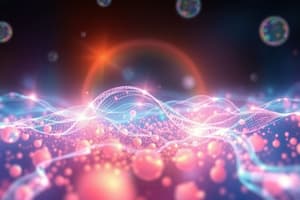Podcast
Questions and Answers
Which transport mechanism requires an input of cellular energy to move molecules?
Which transport mechanism requires an input of cellular energy to move molecules?
- Facilitated diffusion
- Active transport (correct)
- Diffusion
- Osmosis
Diffusion is the movement of molecules from an area of low concentration to an area of high concentration.
Diffusion is the movement of molecules from an area of low concentration to an area of high concentration.
False (B)
What is the term for the difference in concentration of a substance across a space?
What is the term for the difference in concentration of a substance across a space?
concentration gradient
Proteins in the cell membrane that aid in the facilitated movement of molecules across the membrane are called ______.
Proteins in the cell membrane that aid in the facilitated movement of molecules across the membrane are called ______.
Match the type of protein with its role in facilitated diffusion:
Match the type of protein with its role in facilitated diffusion:
What is the specific term for the diffusion of water across a selectively permeable membrane?
What is the specific term for the diffusion of water across a selectively permeable membrane?
Osmosis requires energy input from the cell.
Osmosis requires energy input from the cell.
What are the specialized protein channels that facilitate the rapid movement of water across cell membranes?
What are the specialized protein channels that facilitate the rapid movement of water across cell membranes?
The rate of water movement during osmosis is affected by solute concentration and opposing ______.
The rate of water movement during osmosis is affected by solute concentration and opposing ______.
Match the descriptions to the conditions of a plant cell in osmosis:
Match the descriptions to the conditions of a plant cell in osmosis:
Which of the following is a characteristic of passive transport?
Which of the following is a characteristic of passive transport?
Active transport uses a carrier protein to move molecules from an area of high concentration to an area of low concentration.
Active transport uses a carrier protein to move molecules from an area of high concentration to an area of low concentration.
What type of protein is required for active transport to occur across a cell membrane?
What type of protein is required for active transport to occur across a cell membrane?
The process by which cells engulf large particles or cells is called ______.
The process by which cells engulf large particles or cells is called ______.
Match the type of endocytosis with its description:
Match the type of endocytosis with its description:
What is the primary purpose of exocytosis?
What is the primary purpose of exocytosis?
During exocytosis, the waste material is enveloped in a membrane and fuses with the exterior of the plasma membrane.
During exocytosis, the waste material is enveloped in a membrane and fuses with the exterior of the plasma membrane.
In phagocytosis, once the vesicle containing the engulfed particle is enclosed within the cell, with which organelle does this vesicle merge?
In phagocytosis, once the vesicle containing the engulfed particle is enclosed within the cell, with which organelle does this vesicle merge?
Unlike phagocytosis, ______ is a non-specific process in which the cell takes in whatever solutes are dissolved in the liquid it envelops.
Unlike phagocytosis, ______ is a non-specific process in which the cell takes in whatever solutes are dissolved in the liquid it envelops.
Match the cellular process with whether it requires energy:
Match the cellular process with whether it requires energy:
Which of these factors does not affect the rate of diffusion?
Which of these factors does not affect the rate of diffusion?
Facilitated diffusion requires the cell to expend energy to transport molecules across the membrane.
Facilitated diffusion requires the cell to expend energy to transport molecules across the membrane.
What is the name of the condition where an animal cell swells and potentially bursts due to excessive water uptake in a hypotonic environment?
What is the name of the condition where an animal cell swells and potentially bursts due to excessive water uptake in a hypotonic environment?
In receptor-mediated endocytosis, the specificity of the process is due to receptor proteins located on depressed areas of the cell membrane called ______.
In receptor-mediated endocytosis, the specificity of the process is due to receptor proteins located on depressed areas of the cell membrane called ______.
Match an affected environmental condition of a cell to the condition produced by osmosis:
Match an affected environmental condition of a cell to the condition produced by osmosis:
Which of the following best describes Brownian motion?
Which of the following best describes Brownian motion?
Kidney cells likely have a smaller number of aquaporins in their cell membranes because they don't need to move water as efficiently.
Kidney cells likely have a smaller number of aquaporins in their cell membranes because they don't need to move water as efficiently.
Briefly describe how a carrier protein facilitates the transport of a solute across the membrane in facilitated diffusion.
Briefly describe how a carrier protein facilitates the transport of a solute across the membrane in facilitated diffusion.
During phagocytosis by a neutrophil, a microorganism is surrounded and engulfed forming a vesicle, which is subsequently destroyed by the ______.
During phagocytosis by a neutrophil, a microorganism is surrounded and engulfed forming a vesicle, which is subsequently destroyed by the ______.
Match the transport process with its primary direction relative to the concentration gradient:
Match the transport process with its primary direction relative to the concentration gradient:
Which of the following processes is responsible for the shrinking of a cell in a hypertonic solution?
Which of the following processes is responsible for the shrinking of a cell in a hypertonic solution?
The endosomal membrane becomes part of the extracellular fluid following exocytosis.
The endosomal membrane becomes part of the extracellular fluid following exocytosis.
What is the role of coated proteins in receptor-mediated endocytosis?
What is the role of coated proteins in receptor-mediated endocytosis?
When accessible nutrients from the degradation of vesicular contents have been extracted, the newly formed endosome merges with the ______ and its contents are released into the extracellular fluid.
When accessible nutrients from the degradation of vesicular contents have been extracted, the newly formed endosome merges with the ______ and its contents are released into the extracellular fluid.
Relate the type of solution to what it means for the cell:
Relate the type of solution to what it means for the cell:
Which type of diffusion uses membrane transport?
Which type of diffusion uses membrane transport?
Active Transport requires energy to move molecules from high concentrations to low concentrations.
Active Transport requires energy to move molecules from high concentrations to low concentrations.
Molecules are assisted by what in facilitated diffusion?
Molecules are assisted by what in facilitated diffusion?
Robert Brown discovered the random motion due to kinetic energy of atoms and molecules, today called ______.
Robert Brown discovered the random motion due to kinetic energy of atoms and molecules, today called ______.
Match how each Diffusion Medium affects diffusion:
Match how each Diffusion Medium affects diffusion:
Flashcards
Cellular Transport
Cellular Transport
The movement of materials into and out of cells either passively or actively.
Diffusion
Diffusion
Movement of any molecules from high to low concentration until equilibrium, requires no energy input.
Concentration Gradient
Concentration Gradient
The difference in concentration of a substance in two areas.
Brownian Motion
Brownian Motion
Signup and view all the flashcards
Facilitated Diffusion
Facilitated Diffusion
Signup and view all the flashcards
Channel Protein
Channel Protein
Signup and view all the flashcards
Carrier Protein
Carrier Protein
Signup and view all the flashcards
Osmosis
Osmosis
Signup and view all the flashcards
Aquaporins
Aquaporins
Signup and view all the flashcards
Solute Concentration
Solute Concentration
Signup and view all the flashcards
Opposing Physical Pressures
Opposing Physical Pressures
Signup and view all the flashcards
Hypertonic (animal cell)
Hypertonic (animal cell)
Signup and view all the flashcards
Isotonic (animal cell)
Isotonic (animal cell)
Signup and view all the flashcards
Hypotonic (animal cell)
Hypotonic (animal cell)
Signup and view all the flashcards
Plasmolyzed
Plasmolyzed
Signup and view all the flashcards
Flaccid
Flaccid
Signup and view all the flashcards
Turgid
Turgid
Signup and view all the flashcards
Active Transport
Active Transport
Signup and view all the flashcards
Endocytosis
Endocytosis
Signup and view all the flashcards
Phagocytosis
Phagocytosis
Signup and view all the flashcards
Phagocytosis process
Phagocytosis process
Signup and view all the flashcards
Pinocytosis
Pinocytosis
Signup and view all the flashcards
Receptor-Mediated Endocytosis
Receptor-Mediated Endocytosis
Signup and view all the flashcards
Exocytosis
Exocytosis
Signup and view all the flashcards
Study Notes
- Materials are moved into and out of cells
- Module 1 focuses on cells as the basis of life
- Cells coordinate activities within their internal and external environments
- A practical investigation to model diffusion and osmosis is conducted
- Active transport, endocytosis, and exocytosis are examined
Cellular Transport
- Materials are transported into and out of cells passively or actively
Passive and Active Movement
- Passive involves diffusion and osmosis, which require no energy input
- Active transport requires cellular energy to move molecules
Passive Transport: Diffusion
- Diffusion is the movement of any molecules from high to low concentration until equilibrium with no energy
- Concentration gradient is the difference in substance concentration in two areas, possibly divided by a barrier
Diffusion Demonstration
- First, a colored sugar cube is placed in a large volume of clear water
- Second, the dissolving cube establishes a steep concentration gradient for sugar and dye
- Sugar and dye concentrations are high near the cube and negligible elsewhere
- Third, sugar and dye molecules spread through the solution as time passes
- Eventually, the sugar and dye molecules are evenly distributed throughout the solution
Brownian Motion
- Diffusion results from random motion due to kinetic energy
- This was first discovered by Robert Brown
- Diffusion involves the movement of solid, liquid, or gas molecules through another solid, liquid, or gas
Diffusion Rate Factors
- Diffusion rate depends on the concentration gradient
- A greater concentration difference creates a steeper gradient and faster diffusion
- Diffusion may speed up or slow down, depending on the temperature
- Heat increases the rate because particle kinetic energy speeds up
- Higher temperature results in faster diffusion
- Larger surface area results in faster diffusion
- Higher concentration gradient results in faster diffusion
- Smaller particles result in faster diffusion
- Gas results in fastest diffusion, Liquid results in faster diffusion than solid, and Solid being the slowest diffusion
Facilitated Diffusion
- Some larger and electrically charged molecules move too slowly by simple diffusion to satisfy needs
- Proteins in the cell membrane act as membrane transporters, accelerating molecule movement across the membrane
- The movement is along a concentration gradient with no energy input
- This is facilitated diffusion
Facilitated Diffusion: Protein Assistance
- Facilitated diffusion involves the movement of molecules being assisted by carrier proteins in the membrane
- A protein that acts as a membrane-transporter is specific to one or several solutes
- Facilitated diffusion allows larger or charged molecule movement more rapidly than simple diffusion
Channels and Carriers
- A protein may act as a channel or a carrier protein
- Channels are the fastest form of transport
- These work like gates and have open and closed states, determined by electrical or physical signals
Carrier Proteins
- A carrier protein binds with a solute
- The protein then changes shape/conformation to move the solute to the other side
- Once released to on the other side, the carrier returns to its original shape
Passive Transport: Osmosis
- Osmosis is the movement of water from high to low water concentration
- Transport occurs through a selectively permeable membrane and does not require energy
Aquaporins
- Water moves through protein channels called aquaporins
- Movement of water across membranes occurs much faster than expected
- Tissues with high-water permeability have more aquaporins in membranes
Osmosis Rate Factors
- The rate of water movement depends on two things
- Solute concentration, the concentration including the dissolved substances in the solution
- Opposing physical pressures or tension exerted on the water
Osmosis Effects in Animal Cells
- Water moves according the the concentration inside and outside the cell in animal cells
Osmosis Effects in Plant Cells
- Water moves according to concentration inside and outside cells, causing plasmolyzed, flaccid, and turgid forms
Comparing Diffusion and Osmosis
- Both diffusion and osmosis are examples of passive transport
- Passive transport is characterized by the movement of a substance down a concentration gradient with no cellular energy
Passive Transport Practical Investigation
- The aim is to observe passive transport through dialysis tubing
- Set up the following: create a dialysis tube by tying a string at one end, filling with starch, and tying another end
- Create a 250mL beaker with enough iodine solution
- The tube is now put into the beaker
- Leave the apparatus overnight (away from direct sunlight)
- Record any observations occur
Osmosis First Hand Investigation
- The aim is to observe the process of osmosis by using potatoes
- First, set up distilled and salt water in separate bowls
- Leave the potatoes in each overnight
- Observe and note any changes
Active Transport
- Active transport requires a carrier protein to move chemicals from low to high concentration, using cellular energy
Active Transport: Larger Particles
- In addition to small ions and molecules, cells need to remove and take in larger molecules and particles
- Some cells are capable of engulfing entire unicellular microorganisms
- There are two primary mechanisms for transporting these particles
- Endocytosis
- Exocytosis
Active Transport: Endocytosis
- Endocytosis is the active transport that moves particles into a cell
- There are variations of endocytosis, but all share common characteristics
- The material is surrounded by a plasma membrane area, which buds off inside the cell, forming a pocket
- The pocket pinches off
- The particle is contained in a newly created intracellular vesicle formed from the plasma membrane
Endocytosis Types
- There are three main types of endocytosis
- Phagocytosis
- Pinocytosis
- Receptor-Mediated Endocytosis
Endocytosis: Phagocytosis
- Phagocytosis (cell eating) is the process by which larger particles, like cells or relatively large particles, are taken in
- When microorganisms invade the body, neutrophils remove invaders by phagocytosis
- The neutrophil surrounds and engulfs microorganisms, then destroys them
Phagocytosis Process
- The vesicle merges with a lysosome for material breakdown in the newly formed compartment (endosome)
- Accessible nutrients are extracted from the degradation of the vesicular content
- The newly formed endosome merges with the plasma membrane and releases it contents into the extracellular fluid
- Endosomal membrane becomes part of the plasma membrane again
Endocytosis: Pinocytosis
- A variation of endocytosis is pinocytosis (cell drinking)
- Molecules, including water, needed from the extracellular fluid are taken in
- Pinocytosis is a non-specific process
- The cell takes in the solute that are dissolved in the liquid it envelops
Differences in Pinocytosis
- Pinocytosis results in a much smaller vesicle that does not merge with a lysosome
Receptor-Mediated Endocytosis
- Receptor-mediated endocytosis is an extremely selective importing process
- Specificity occurs by receptor proteins located on depressed areas of the cell membrane called coated pits
- The cytosolic surface of coated pits is covered by coat proteins
Receptor-Mediated Endocytosis Process
- A cell only takes in an extracellular molecule if it binds to the specific receptor protein on the cell's surface
- Once bound, the coated pit pinches in to form a coated vesicle
- The coated vesicle fuses with a lysosome to digest the engulfed material which is released into the cytosol
Active Transport: Exocytosis
- Exocytosis is the process of cell secretion or excretion
- Its purpose is to expel material from the cell into the extracellular fluid
- Waste material is enveloped in a membrane and fuses to the interior of the plasma membrane
- This fusion opens the membranous envelope on the exterior
- Waste material is expelled into the extracellular space
Summary of Cellular Transport
- Diffusion/facilitated diffusion
- High concentration of particles to low concentration of particles
- Movement is along he concentration gradient
- The movement of any type of molecule from high to low concentration until equilibrium is reached
- Osmosis
- Has a selectively permeable membrane
- High concentration of water molecules to low concentration of water molecules
- Movement along concentration gradient
- Water movement from high to low occurs through a selectively permeable membrane
- Active Transport
- Has a selectively permeable membrane
- Movement against concentration gradient
- Solute moves from low concentration to high through a selectively permeable membrane
Cellular Transport Comparison
- Active transport: occurs through carrier proteins
- Fast rate of movement
- Low to high concentration
- Requires energy
- Transports sugars and amino acids
- Passive transport: occurs through carrier proteins via facilitated diffusion or between phospholipids via osmosis and diffusion
- Slow rate of movement
- High to low concentration
- No energy required
- Transports water, oxygen, carbon dioxide, sugars, and amino acids
Studying That Suits You
Use AI to generate personalized quizzes and flashcards to suit your learning preferences.





